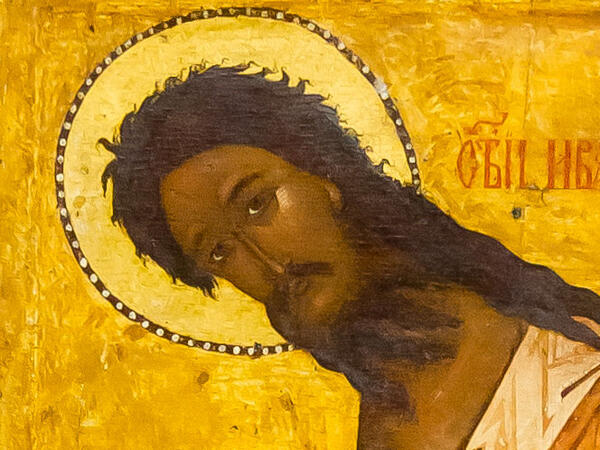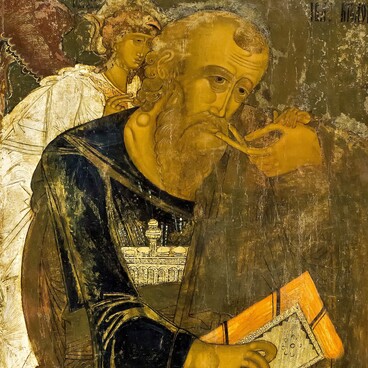The image of John the Forerunner was painted in the first third of the 16th century. Saint John is called both the Forerunner and the Baptist — the former for coming into the world before Christ and telling people about His coming, and the latter for baptizing the Savior in the Jordan River. He is considered one of the most revered saints. The Savior himself spoke of him, ‘Verily I say unto you, Among them that are born of women there hath not risen a greater than John the Baptist’.
In iconography, the saint is usually depicted as a hermit who is dressed in clothes of camel’s hair called a mantle. This detail comes from the story of the saint’s life as told in the Gospel of Luke. Led as an infant into the desert by an Angel, John lived the life of a recluse for thirty years, until he was called to baptize the people of Israel. In rare cases, the saint is depicted in a long shirt with wide sleeves (chiton) and a cloak (himation), as in this icon from the museum collection, which belongs to the Deesis row of the iconostasis.
In the Deesis row, the saint could be depicted in various ways — both in a mantle or in a chiton with a cloak. The Deesis is the central tier of the iconostasis, with the image of Jesus Christ in the middle. The Savior is placed among the saints turned to Him in prayer. The museum houses the Deesis row that includes nine icons: images of Christ the Almighty on the throne, the Mother of God and John the Baptist, the archangels Michael and Gabriel, the apostles Peter and Paul, St. Basil the Great and John Chrysostom. The icons of the saints are stored in the museum funds.
The icon of John the Baptist is known to have been repeatedly restored. During the process, it was possible to restore not only the damaged parts, but also the old original elements. This was noted by Vladimir Sokol in his 1922 article. He focused on the specific arrangement of St. John the Baptist’s figure, believing that during the last renovation the restorer changed the way the saint’s legs were painted — both feet are pressed close to each other. But after comparing the images of St. John the Baptist to similar examples of the Novgorod art, one can notice that a close arrangement of the saint’s feet is often found in the Deesis row and in icons of the feasts. For example, John the Baptist is depicted this way in the icon of the Presentation of Jesus Christ from the iconostasis of the Assumption Cathedral of Sviyazhsk.
The style of the Deesis row icons kept in the museum is distinguished by a rich color scheme and elongated proportions of the saints’ figures. These composition techniques make the icons monumental. However, the size of the row leads to think that the church building, that the icons were from, was not high. In April 1920, the icons were received by the Kazan Provincial Museum (now the National Museum of the Republic of Tatarstan) from the All-Russian Collegium for Museum Affairs and the Protection of Monuments of Art and Antiquities.
A surviving letter from the art critic Igor Grabar to his friend Pyotr Dulsky described the transfer of the 15th century Novgorod apostolic row of icons. Later, Pyotr Kornilov, head of the ancient Russian art department of the Central Museum of the Tatar ASSR, dated this Deesis to the 16th century.
In iconography, the saint is usually depicted as a hermit who is dressed in clothes of camel’s hair called a mantle. This detail comes from the story of the saint’s life as told in the Gospel of Luke. Led as an infant into the desert by an Angel, John lived the life of a recluse for thirty years, until he was called to baptize the people of Israel. In rare cases, the saint is depicted in a long shirt with wide sleeves (chiton) and a cloak (himation), as in this icon from the museum collection, which belongs to the Deesis row of the iconostasis.
In the Deesis row, the saint could be depicted in various ways — both in a mantle or in a chiton with a cloak. The Deesis is the central tier of the iconostasis, with the image of Jesus Christ in the middle. The Savior is placed among the saints turned to Him in prayer. The museum houses the Deesis row that includes nine icons: images of Christ the Almighty on the throne, the Mother of God and John the Baptist, the archangels Michael and Gabriel, the apostles Peter and Paul, St. Basil the Great and John Chrysostom. The icons of the saints are stored in the museum funds.
The icon of John the Baptist is known to have been repeatedly restored. During the process, it was possible to restore not only the damaged parts, but also the old original elements. This was noted by Vladimir Sokol in his 1922 article. He focused on the specific arrangement of St. John the Baptist’s figure, believing that during the last renovation the restorer changed the way the saint’s legs were painted — both feet are pressed close to each other. But after comparing the images of St. John the Baptist to similar examples of the Novgorod art, one can notice that a close arrangement of the saint’s feet is often found in the Deesis row and in icons of the feasts. For example, John the Baptist is depicted this way in the icon of the Presentation of Jesus Christ from the iconostasis of the Assumption Cathedral of Sviyazhsk.
The style of the Deesis row icons kept in the museum is distinguished by a rich color scheme and elongated proportions of the saints’ figures. These composition techniques make the icons monumental. However, the size of the row leads to think that the church building, that the icons were from, was not high. In April 1920, the icons were received by the Kazan Provincial Museum (now the National Museum of the Republic of Tatarstan) from the All-Russian Collegium for Museum Affairs and the Protection of Monuments of Art and Antiquities.
A surviving letter from the art critic Igor Grabar to his friend Pyotr Dulsky described the transfer of the 15th century Novgorod apostolic row of icons. Later, Pyotr Kornilov, head of the ancient Russian art department of the Central Museum of the Tatar ASSR, dated this Deesis to the 16th century.



